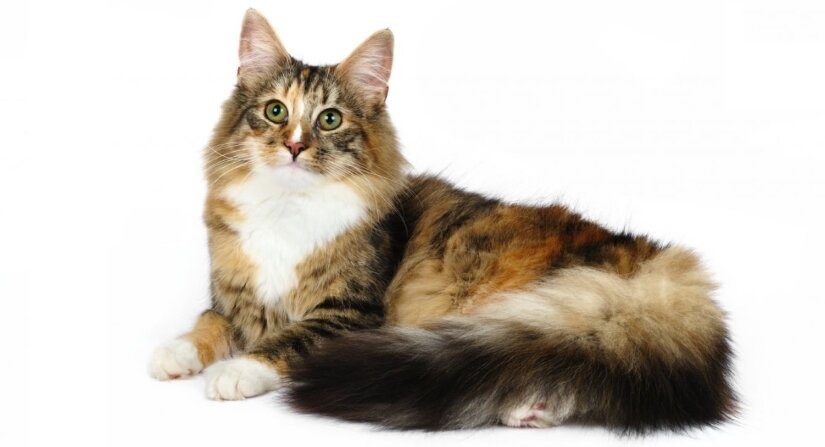The Norwegian Forest originated from Norway. This magnificent cat breed is known as the Norsk Skogkatt. It is almost lynx-like, and up until 1938 was a domestic longhaired stray cat in Norway. It looks like the Maine Coon. The Norwegian Forest cat breed has the most fabulous coat, and makes for a wonderful companion.
Brief History
It is thought that the Norwegian Forest cat breed may be descendants of cats that the Vikings brought to Norway from the U.K, and the longhaired cats brought in by the Crusaders. These are forest cats that had to survive the harsh, cold winters of Norway on their own. In 1938 the Norwegian Forest Cat Club was formed in Norway. The club’s aim was to preserve the breed that was becoming extinct after WW2. By 1975, the Norsky Skogkattrino Association was formed, which led to a breed standard for the Norwegian Forest cat breed. In 1993 the CFA board accepted the Norwegian Forest cat breed for complete championship status. The Norwegian Forest Cat breed was registered with the American Cat Fanciers Association in 1994.
Physical Description



The Norwegian Forest is a playful and active cat breed. This is a cat breed that is larger than most cat breeds. The head is triangular and long. The chin is strong, and the muzzle is of medium length. The ears are large and triangular with ear tufts. The eyes are almond–shaped, and of any color. The body is heavy-boned and strong. The legs are long, and the tail is bushy. The coat is waterproof, thick and long, with an undercoat. The undercoat is wooly. The coat is thickest on the legs, chest, and head areas. All coat colors are accepted apart from chocolate, lilac, and fawn and cinnamon dilutions. This cat breed are strong climbers, even on rocks. The voice is quiet, and the temperament sweet and playful. This is a very active cat breed that demands attention. The Norwegian Forest becomes very vocal when around dogs.
Temperament
The Norwegian Forest cat breed is an active and intelligent cat breed. This cat breed does well with people, gentle dogs, other cats, and animals. This cat breed enjoys climbing, and being both indoors and outdoors. Keeping your cat safe is important because it is adventurous and active. The Norwegian Forest cat breed enjoys hanging out next to you by your computer or on the couch, and gets on well with dogs, and other animals that are not aggressive.
The Norwegian Forest cat will follow you around the house, and snuggle on your lap when he wants to. This very vocal cat breed is quirky, and will have occasional bursts of energy. That said, it’s important to have organized playtime with this breed to get them tired. The Norwegian Forest needs an environmentally stimulating home with plenty of cat climbers, scratching posts and feline toys. This breed does well going for long walks with his pet parent. Consult with your veterinarian as to the best cat leashes and harnesses for your Norwegian Forest cat breed.
The Norwegian Forest cat breed needs to be in a safe, cat friendly environment that is beneficial to its temperament. This wonderfully active cat breed does well with adoring cat parents, and should not be around aggressive dogs or rambunctious children, since they need to run and play in a safe environment, without dogs chasing after them. This breed can be taught to bring back cat toys when called. This cat breed is very demanding, and can become very vocal when asking for something.
Positive clicker training with rewards works best with the Norwegian Forest cat to prevent excessive scratching in the wrong places. This breed learns quickly, and is wonderful to live with. Providing your cat with scratching posts, clean litter boxes, stimulating and safe cat toys, help to ensure a well-balanced and confident Norwegian Forest cat.
Special Needs
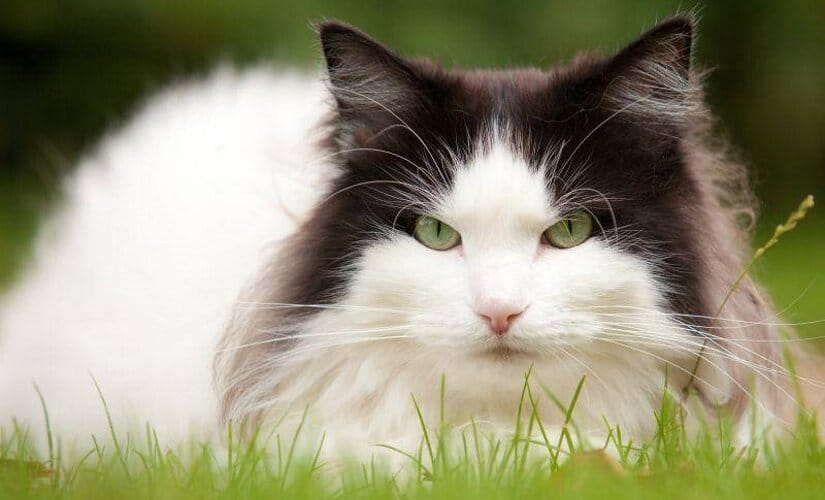
There are numerous feline behavioral problems that may be present in your Norwegian Forest cat, as well as in all other cat breeds.
Hyperesthesia may be present in some cat breeds. This is when your cat is oversensitive to touch, especially along the back area. Cats with this problem may become angry when handled. Other feline behavioral problems that you may be faced with are compulsive behaviors. These would fall under normal feline behaviors that tend to occur often, and interfere with your cat’s daily life. Examples of this would be excessive grooming, or excessive chewing of fabrics. Compulsive behaviors in felines tend to occur when cats are stressed out. Always try to keep your Norwegian Forest cat in a relaxed environment. Consult with your veterinarian about a behavior modification program, and possibly medication for your cat to manage these feline behavioral problems.
All cats are mainly solitary hunters, and some may require time spent alone. Most cat breeds are affectionate and thrive for attention from their feline parents, but on their own terms. The Norwegian Forest cat breed, like all cats, is sensitive to smell, and will try cover up bad smells. It is important to keep all litter boxes clean. That said, all domestic cats like the Norwegian Fold, are still “mousers”, and will enjoy playing mouse with their cat toys and pet parents. Consider setting aside playtime with your cat to ensure bonding through playtime.
The Norwegian Forest cat is intelligent, gentle, yet active. This breed matures late, and will be playful for many years. It is a breed that does well with either apartment or house living. This cat breed does best as both an indoor and outdoor cat. Cats do best if kept secure indoors, so that they do not stray away from home. This cat breed thrives on affection, and plenty of cat toys. This breed needs to be indoors during the hot summer months, as it is may be heat sensitive. It is a wonderfully easy cat breed to live with, but does need mental stimulation and plenty of exercise. This cat breed gets bored when alone for long periods of time. Consider getting a best friend for your Norwegian Forest cat if you’re out at work all day!
Exercising your cat may be challenging, yet cat parents can do so by purchasing certain cats toys to promote exercise. Litter box training needs to start during kittenhood. All cats are super clean animals, so it is very easy to litter box train. Litter boxes for cats need to be kept clean, or your cat may not use it. These should be kept in a low traffic area of your home that is easily accessible to your cat. This cat breed enjoys being high- up. Cat trees are very important to keep your Wegie content.
All cats will need parasite control and routine health care throughout its life. This means vaccinating your cats. This is an important part of keeping your cats healthy throughout their lives. Your cat will also need to be spayed or neutered. Consult with your veterinarian, and always consider veterinary health insurance for your cat. Special care needs to be given to health needs.
Possible Health Concerns
The Norwegian Forest cat is a healthy and moderately active cat breed that may be susceptible to the following health conditions:
- Hypertrophic Cardiomyopathy (HCM): This is a heart muscle disorder where the heart walls of the left ventricle thicken. This results in the walls becoming stiffer. This is a common primary heart disease in cats. It tends to noticed at around 3 months to 17 years of age. Most cats will be middle aged when this disorder occurs. This disorder tends to affect males more than females, and it is an inherited genetic defect. Symptoms may include difficulty breathing, weakness or paralysis of the hind limbs. Fluid may also accumulate in the lungs, and in the space between the lungs and chest wall. Veterinary treatment will aim at improving cardiac function, and reducing blood clots. There is a good longterm outlook for mildly affected cats. Consult with your veterinarian for advice.
- Hip Dysplasia: This is rare in domestic cats, and is common in purebred cats. This occurs when the hip joint is loose, and leads to degenerative joint disease. (osteoarthritis) Symptoms include lameness that can be mild to severe. Cats generally need no surgery for hip dysplasia. Weight reduction can help reduce discomfort.
- Glycogen Storage Disease Type IV: The body converts glycogen to glucose for energy. Cats with this disease may weaken progressively, until they cannot get up. Kittens can die from this. This disease usually can be noticed by 4-5 months, and is deadly. Consult with your veterinarian for advice.
- Polycystic Kidney Disease. This occurs when the polycystic kidney has numerous cysts within the functioning part of the kidney resulting in enlarged kidneys. Consult with your veterinarian if your cat vomits frequently, has a decreased appetite, and increased thirst or urination.
Exercise
When choosing cat toys for your Norwegian Forest cat opt for toys that allow the entire family to play together. Toys like the Shimmer Glimmer are shimmery and plush, and allow for all cats to have plenty of fun with everyone. The wands allow for change-out-toys to prevent your Wegie from getting bored.
The Wegie cat breed needs daily exercise combined with plenty of mental stimulation through active play and interaction with people. Cat parents can use cat toys like the Mousr or Cat Dancer to get their cats to play. This will encourage your cat to play. Finding a variety of mentally stimulating cat toys will allow for your cat to lead a well-balanced life, with the right amount of exercise and mental stimulation. Cat harnesses also allow for daily walks.
The Wegie is an active cat breed, that thrives on attention and free-play. That said, this cat breed still needs to play and interact with people, but needs to have plenty of environmental stimulation 24/7. Cat gyms, cat scratchers, and interactive cat toys within a cat friendly home environment work best for this fabulous cat breed.
Look out for the latest cat toys like Ripple rug play mats, the Feather Whirls, pet cube toys, food trees, turbo scratcher toys, cat companion interactive toys, and electronic motion toys. All these and many more will keep your cat entertained when you’re out and about. Chasing, hunting, and attacking toys are some of the methods that cats will use when playing with interactive toys. When out shopping for cat toys, opt for safe TPA materials that have no toxic BPA or BHT. Ultimately, what feline pet parents need to achieve is bonding through free play and exercise.
Nutrition
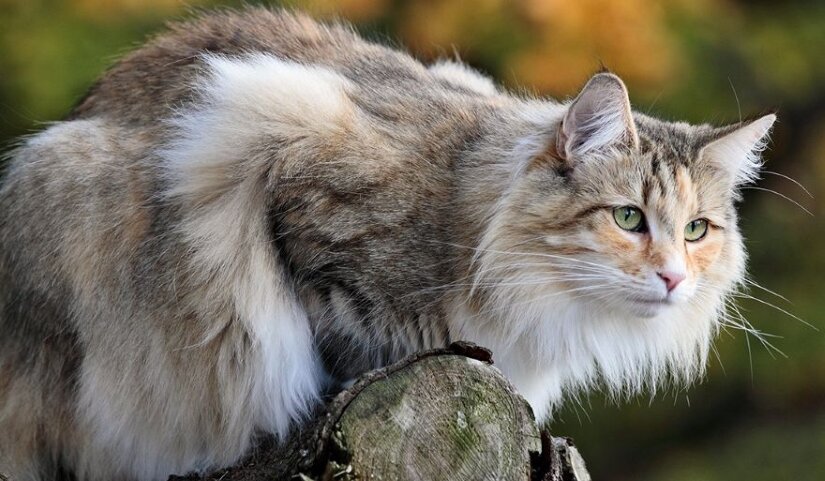
Feeding your cats, the right amount of food is important. When overfeeding cats, obesity and overworking a cat’s digestive system occurs. When underfeeding, numerous other health concerns occur. If in doubt, consult with your veterinarian for advice on how much to feed your Norwegian Forest cat.
The Norwegian Forest cat breed will need proper nutrition. That said, a high-quality diet that is appropriate for the specific life stage of the cat is necessary. Protein as an ingredient, needs to come first. Dry cat food is a popular choice because it promotes healthier gums and teeth. Yet, wet food is highly recommended by veterinarians because it provides more moisture to cats.
Cats don’t drink a lot of water and tend to sometimes get dehydrated. Wet cat food also has its benefits. By choosing a well-known name-brand cat food that has scientific backing, as well as quality control, cat parents can be assured that they are providing a well-balanced diet. Recipes that include hairball control management and digestive support, together with a balanced formula and natural ingredients, provide good nutritional support. They are made with special fibers that prevent hairballs.
All cat breeds need high- quality fat and protein in their diets. They also need amino acids, including taurine that cannot be found in either human food or dog food. There are also numerous specialty diets for your cat that are formulated specifically for certain medical problems like urinary tract disorder, obesity, or kidney disease.
All cats do well by being fed twice daily. During kittenhood, kittens will need to be fed every few hours. Growing kittens need more calories, nutrients, vitamins, protein, and calories. Your cat should be able to enjoy a peaceful meal in a quiet corner of the house. Some cat parents prefer to leave cat kibble out 24/7. When looking for a high-quality cat food, here’s what to look out for:
- No low-quality fillers
- No artificial additives
- Low grade ingredients or toxic ingredients
- All cat food has to be meat-based because all cats are carnivores.
- No garlic
- Plant-based ingredients should be listed after the protein-based ingredients
Consult with your veterinarian for the best dietary advice for your cat.
Grooming
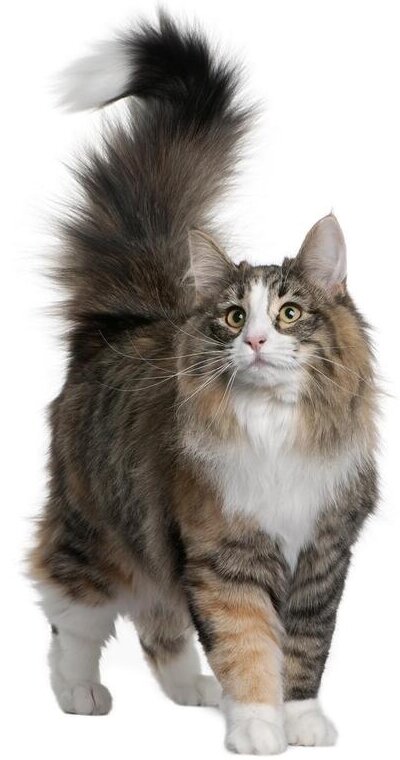
Cat pampering is a norm today with feline pet parents wanting the very best for the cats. Your Norwegian Forest cat may be susceptible to skin diseases originating from flea bites, mites, yeast infections, and infections. Opt for natural cat grooming products to help resolve these skin irritants.
All cat breeds have highly sensitive skin. By using grooming wipes and waterless shampoos in between bathing schedules, you’ll have a healthier cat.
The Norwegian Forest cat breed needs daily grooming to remove shedding hair, and to prevent hair from matting. Because this breed has a long and thick double coat, extra grooming care is required. Stainless steel combs help to remove dead hair. Care must be taken when grooming leg hair and body hair to avoid missing spots that could tangle or mat easily. The Wegie has much less hair during the summer. During the cold winter months, the coat is full, long and thick. The coat is waterproof.
Curry brushes help with grooming, and will remove dead hair and debris from your cat’s coat. All cat breeds will groom themselves several times throughout the day. Daily grooming is necessary because it limits the amount of hair that your cat will consume. This helps limit the development of hairballs. Your cat will enjoy being groomed. Coat hair always looks best during the cold winter months. Cats that have been spayed or neutered will have great coats year- round. This is because hormonal changes in cats affects coat length and thickness.
Cat parents can remove mats by using cat clippers which are safer than using scissors. Daily cleaning with pet wipes beneath the tail is necessary. Ears should be checked weekly for cleanliness and sensitivity. If there is a build-up of wax and dirt, organisms can lead to an ear infection. Consult with your veterinarian about safe and gentle ear cleaning techniques. Nail trimming is necessary every few weeks. Eyes should also be cleaned gently every morning with cotton wool or a soft wipe. Each eye should be cleaned with different wipes or cotton balls to avoid eye infection contamination in both eyes.
Healthy cats need minimal bathing with a gentle cat shampoo. Your cat will need dental care as well. By feeding dry food, and having professional dental cleanings with your veterinarian throughout your cat’s lifetime, your cat will have less of a chance of developing gingivitis or gum disease.
Small and frequent effective hygiene habits will make a big difference in maintaining healthy skin, healthy teeth, and good overall health. Look for environmentally safe pet products that have natural ingredients.
There are so many wonderful feline products like the warming cat mat that makes grooming comfortable for your Wegie. It is designed to help aching joints, and increase blood circulation. Rosemary feline shampoo bars have essential oils that also help to improve circulation, all the while moisturizing hair and skin, and preventing hair loss in your cat.
Adopting a Norwegian Forest Cat
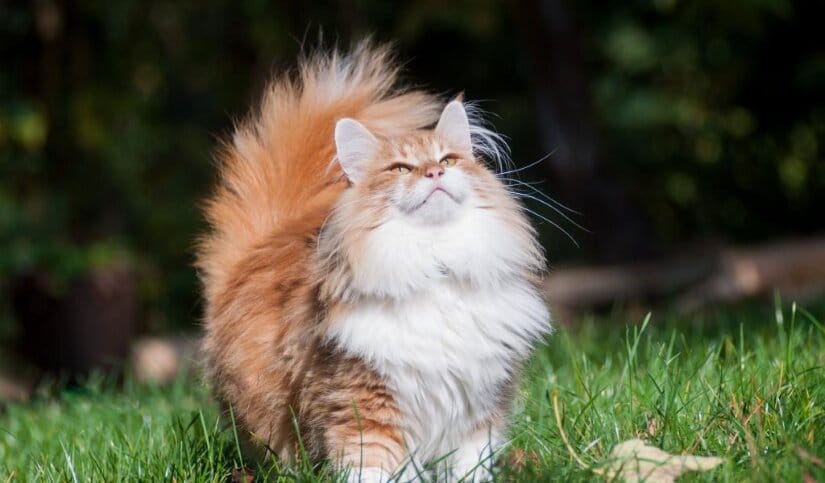
The Norwegian Forest has been the fifth most popular cat breed in France since 2003. With their super sweet personality, and upbeat attitude, the Wegie makes for a fun companion. There are so many cats in shelters today that desperately need a good home. When choosing your Wegie, ask questions, and look for a great temperament! That said, numerous cats can be quirky at shelters, but soon settle down in their new homes, and become very friendly and sociable.
Adopting a kitten is also an option. In addition, kittens should be playful and curious. Sickly kittens that have bad odors or plenty of diarrhea stains, and a dull coat need to be seen by a veterinarian as soon as possible. Kittens when ill, can go downhill very quickly. However, the rewards of adopting a sick animal and caring for it are tremendous, provided that good veterinary care is provided right away. Keep in mind that vaccinations and parasite control are an important part of feline health care. Consider pet health insurance for your cat. With so many great and affordable pet health plans available today, there’s no reason to avoid keeping your pet covered in case of an emergency.
Your cat will also need to be protected from household hazards, most especially electrical cables, poisonous plants, medication, and open windows. The Wegie makes for a wonderful adoption! As usual, make sure that children are always gentle and quiet around cats.
Give your cat time to adjust to his new surroundings. As with any cat adoption, make sure that you have the time and resources to take good care of your Wegie.
Frequently Asked Questions
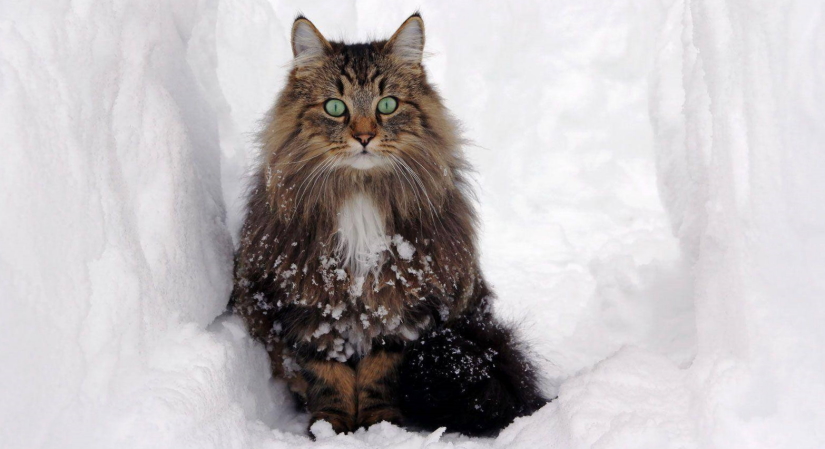
Do Norwegian Forest Cats meow?
The Norwegian Forest cat is a shy cat breed that does not meow a lot but will meow at their pet parents to get something they want.
Do Norwegian Forest cats shed a lot?
The Norwegian Forest cat does shed. This breed has a beautiful fluffy double coat. They will have stages of heavy shedding, but if you groom, often it will not be a problem.
Are Norwegian Forest cats hypoallergenic?
No. This is a long-haired cat breed that is a heavy shedder. This cat breed needs daily brushing because they have dense undercoats.
Which is bigger, Maine Coon or Norwegian Forest Cat?
Both are large domesticated cats, and both are roughly the same size. The Main Coon may grow larger.
Are Norwegian Forest Cats easy to train?
If you use positive training, you’ll be able to house train your Norwegian Forest Cat. This is an intelligent cat breed, but you’ll need to get a large litter box because of its size.
Are Norwegian Forest Cats friendly?
Yes. This cat breed is amiable and affectionate and enjoys plenty of cuddles. This is a domesticated cat breed that makes for a wonderful best friend.
Where does the Norwegian Forest cat originate from?
This cat breed originally came from Norway.
How much is a Norwegian Forest Cat?
You can spend from as little as a few hundred dollars to around $2000. This will all depend on the breeder, location, and pedigree of your Norwegian Forest Cat.
How long does a Norwegian Forest cat take to grow into an adult?
This can take as long as five years before your Norwegian Forest cat has grown into a mature adult. The Norwegian Forest cat is a cat breed that matures slowly.
How long does the Norwegian Forest cat live up to?
The Norwegian Forest cat generally has a lifespan of up to 15 years if well taken care of. Look out for heart issues and hip dysplasia since they may be genetically prone to these health conditions.
Are Norwegian Forest cats rare?
Yes. This breed originated from Norway and is a rare cat breed. The Norwegian Forest cat evolved in the wild over time and is a “naturally” rare cat breed.
Norwegian Forest Cat Breeders in the USA
Norsestar Norwegian Forest Cats (Illinois)
- Address
- Morris, Illinois
- Website
- www.norsestarnfc.com
- Phone
- (815) 5459813
- marjnelson@aol.com
Forestdolls (Wisconsin)
- Address
- Arpin, Wisconsin
- Website
- miniamericaneskimos.homestead.com
- Phone
- (715) 6523349
- snopals@yahoo.com
Skogberg Cattery (Colorado)
- Address
- Longmont, Colorado
- Website
- skogbergcats.com
- kari@skogbergcats.com
Finnishline (New York)
- Address
- New York
- Website
- www.finnishline-forestcat.com
- FinnishlineNFC@gmail.com
Deambarino Cattery (South Carolina)
- Address
- Greenville, South Carolina
- Website
- www.de-ambarino.com
- Phone
- (864) 5532072
- deambarino@yahoo.de
Catequil Cattery (Iowa)
- Address
- Bondurant, Iowa
- Website
- www.catequilcat.com
- Phone
- (515) 3143376
- catequilcat@yahoo.com
Breeders in the Canada
Saskkats Norwegian Forest Cats
- Address
- Spruce Grove, Alberta
- Website
- www.saskkats.com
- Phone
- (780) 9870124
- saskkats@saskkats.com
